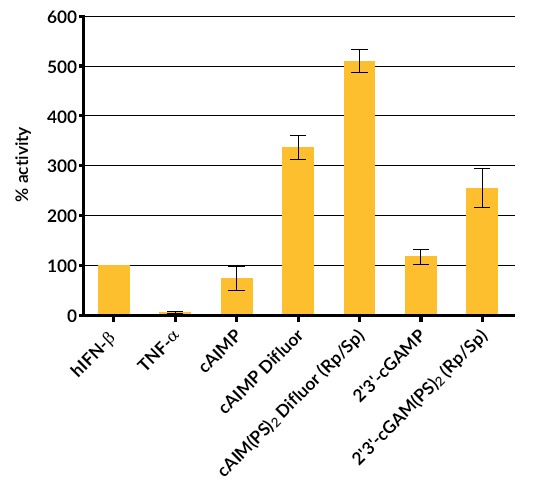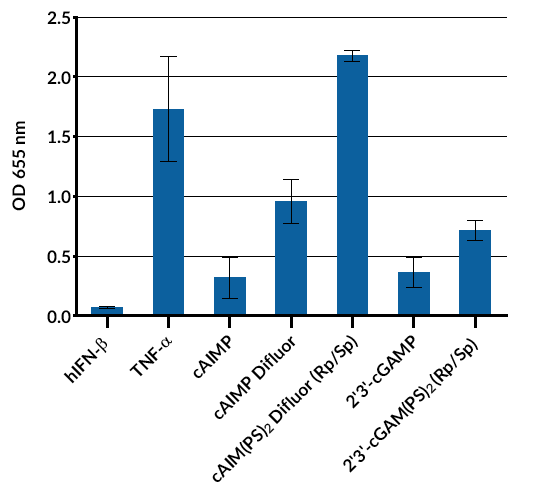cAIMP Difluor (CL614)
| Product | Unit size | Cat. code | Docs. | Qty. | Price | |
|---|---|---|---|---|---|---|
|
cAIMP Difluor cAIMP difluorinated, a STING ligand |
Show product |
2 x 250 µg |
tlrl-nacaidf-05
|
|
cAIMP difluorinated
InvivoGen's cAIMP Difluor (also known as CL614) is a derivative of cAIMP, an analog of the bacterial cyclic dinucleotide (CDN) 3’3’-cGAMP [1].
cAIMP and cAIMP Difluor are novel STING (stimulator of interferon genes)-activating synthetic CDNs.
Unlike natural CDNs, whose constituent nucleosides are guanosine and/or adenine, cAIMP and its derivatives contain one adenine nucleoside and one inosine nucleoside.
cAIMP Difluor is composed of two 2’-deoxynucleosides with a fluorine atom at 2’ position of each nucleoside.
STING ligands such as cAIMP induce the production of type I interferons (IFNs) and of proinflammatory cytokines through the IRF and NF-κB pathways, respectively.
The incorporation of fluorine into biologically active molecules is commonly used in medicinal chemistry to improve their metabolic stability or to modulate physicochemical properties such as lipophilicity [2]. Moreover, the introduction of a fluorine atom can change the biological activities of a molecule. Indeed cAIMP
Difluor (referred to as compound 52 by Lioux et al. [1]) more potently induces interferon regulatory factor (IRF) and NF-κB pathways in a STING‑dependent manner when compared to STING agonists such as 2’3’‑cGAMP and DMXAA [1]. Interestingly, cAIMP Difluor is more resistant than 2’3’‑cGAMP and cAIMP to cleavage by certain nuclease and phosphodiesterase enzymes [1].
To facilitate the srudy of STING ligands, InvivoGen has developed stable reporter cells in two well established immune cell models: THP-1 human monocytes and RAW 264.7 murine macrophages. These cells express inducible SEAP and/or Lucia luciferase reporter genes under the control of an IRF-inducible and NF-κB promoter.
References:
1. Lioux T. et al., 2016. Design, synthesis, and biological evaluation of novel cyclic adenosine-inosine monophosphate (cAIMP) analogs that activate stimulator of interferon genes (STING). J Med Chem. 59(22):10253-10267.
2. Böhm HJ. et al., 2004. Fluorine in medicinal chemistry. Chembiochem. 5(5):637-43
Specifications
Source: Synthetic
Synonym: c-(2’FdAMP-2’FdIMP) sodium salt
CAS: 1951464-78-0
Formula: C20H21F2N9O11P2 .2Na
Molecular weight: 663.4 (free acid), 707.4 (sodium salt)
Solubility: 50 mg/ml in water
Quality control:
- Purity and structure has been determined by LC/MS and NMR: ≥ 95%
- The biological activity of cAIMP Difluor has been confirmed using cellular assays.
- The absence of bacterial contamination (e.g. lipoproteins & endotoxins) has been confirmed using HEK-Blue™ TLR4 and HEK-Blue™ TLR2 cells.
Contents
-
2 x 250 μg of cAIMP Difluor provided lyophilized.
Note: cAIMP Difluor is sterile filtered prior to lyophilization. - 1.5 ml endotoxin-free water
![]() Product is shipped at room temperature
Product is shipped at room temperature
![]() Upon receipt, store at -20 °C.
Upon receipt, store at -20 °C.
Back to the top









